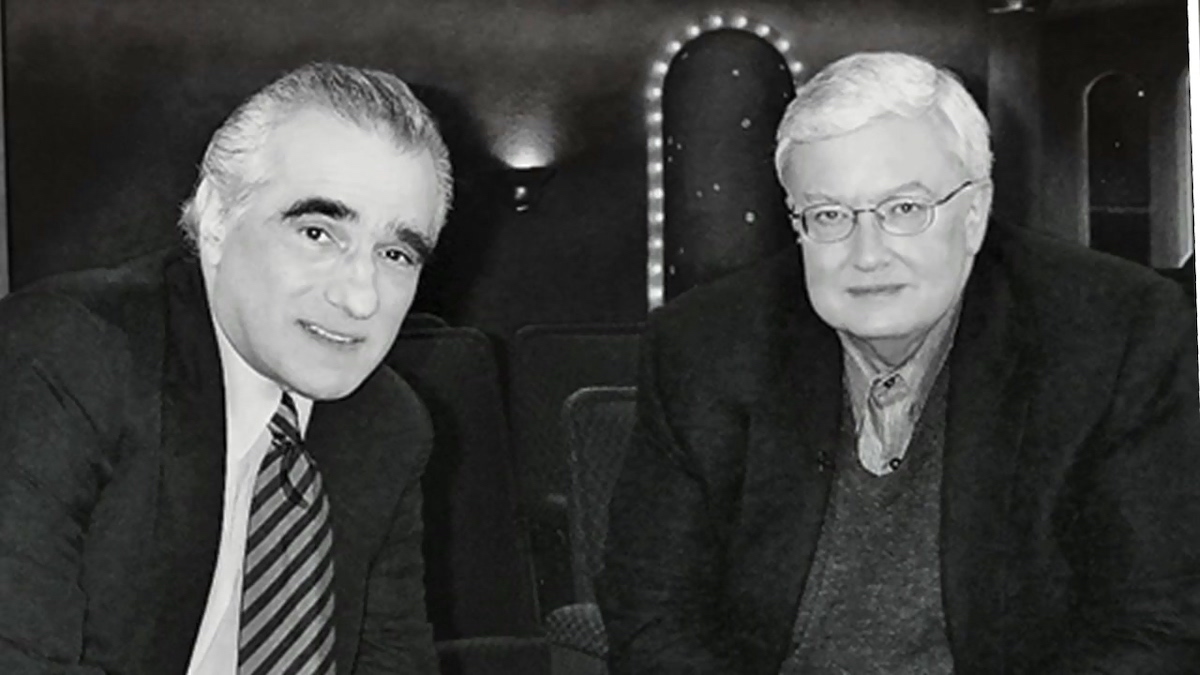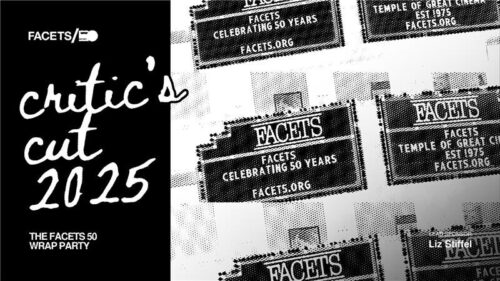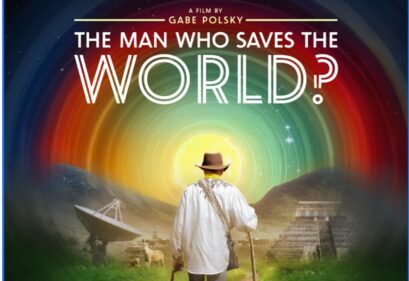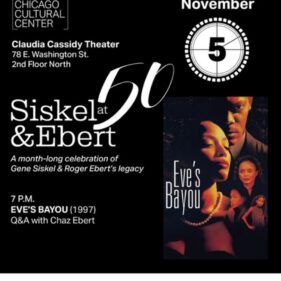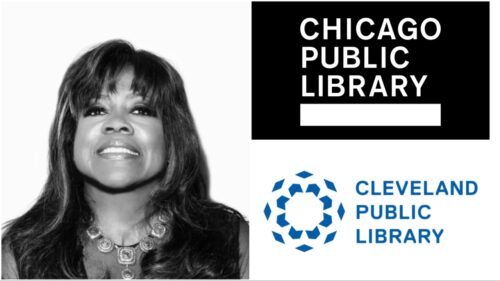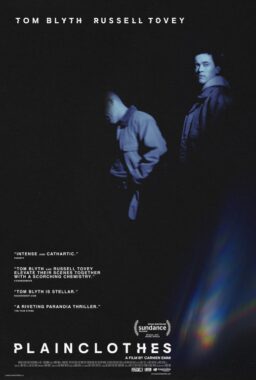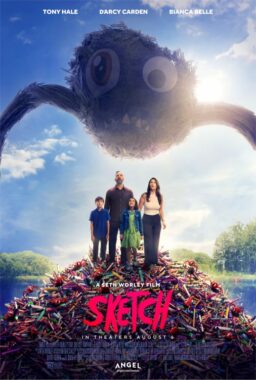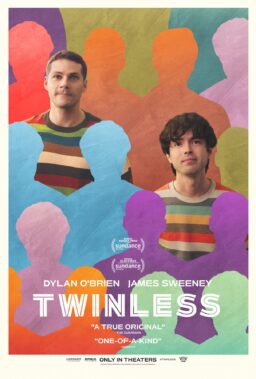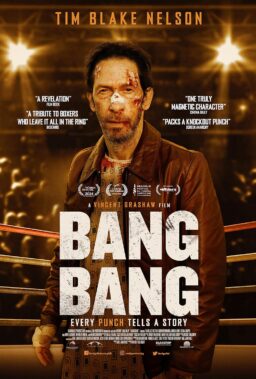Roger called Martin Scorsese the most gifted director of his generation, America’s finest filmmaker…
I am at the Cannes Film Festival where Martin Scorsese’s latest film, “Killers of the Flower Moon” will premiere Saturday, May 20th. So I felt it was time to update our series “Roger’s Favorites” to finally add the one director I knew to be Roger’s personal favorite. Roger said that Scorsese never made an “unworthy film.” And so our Literary Editor Matt Fagerholm and I combed through all of the reviews we could find so that we could present Roger’s own words in praise of Marty. But the reviews don’t tell the whole story. In the introduction to Roger’s book “Scorsese By Ebert,” he examines why he developed such a lasting bond with Marty citing the similarities in their backgrounds even though they were from two different worlds.
“We were born five months apart in 1942, into worlds that could not have differed more: Martin Scorsese in Queens, me in downstate Illinois, but in important ways we had similar childhoods. We were children of working-class parents who were well aware of their ethnic origins. We attended Roman Catholic schools and churches that, in those pre-Vatican II days, would have been substantially similar. We memorized the Latin of the Mass, we were drilled on mortal sins, venial sins, sanctifying grace, the fires of hell; we memorized great swathes of the Baltimore Catechism. We were baffled by the concept of Forever, and asked how it was that God could have no beginning and no end. We were indoors children, not gifted at sports: ‘That boy always has his nose buried in a book.'”
He continues: “We went to the movies all the time, in my case because television came unusually late to my home town, in Scorsese’s because to begin with his father took him, and then he went on his own, sometimes daily, watching anything and learning from it. He became fascinated by the details. I saw the story, he saw the films. He has spoken again and again of a single shot of Deborah Kerr in Powell and Pressburger’s ‘Black Narcissus’ that arrested his attention. Something had happened there, and he couldn’t see what it was, or how it was done. Years later, he was to enlist Powell as a consultant, and discover the answer to his question. By then, he was already one of the greatest directors in film history.”
Roger and Marty didn’t consider themselves “good friends” in the sense that there was a professional distance film critics and filmmakers kept from each other. They did, however, have a respect for each other’s intelligence, passion for family and the movies, and a certain moral core each exhibited in their respective works. They had an easy relationship never trying to impress the other, but existing more as peers who both loved the movies. In that sense, there was a brotherhood that formed that both men enjoyed right up until Roger’s death.
I truly believe that each glimpsed and had an abiding respect for the other’s humanity. You could see the fun they had when Marty appeared on “Ebert Presents At The Movies” with Roger to give a rundown of the Top Movies of the 1990’s. And Marty was gracious to appear at the American Pavilion in Cannes in 2009 to help cut the ribbon to anoint the Roger Ebert Conference Room, which exists in the South of France to this day. In “Life Itself,” Marty tells the story of getting an award at the Toronto Film Festival at the recommendation of Roger and Gene Siskel. He said it was at a time when things were not going well in his life, and that that event helped put him back on the right path. So it goes deeper than the movies. It touches on life itself.
And as a summation in Roger’s own words from his book. “He (Martin Scorsese) is a man of fierce energy, of inner fires burning high. He works hard, is endlessly curious, {and} is intoxicated by great films… does not procure screenplays and film them, but uses screenwriters as collaborators to argue over ideas. Paul Schrader, who has worked with him so long, speaks of him as like a chess opponent who does not mind losing a piece to a good move. He likes the game. He doesn’t bully writers but engages with them. I wonder if he is too social and verbal to sit alone in a room and write a screenplay, as Schrader does by nature. I think for him writing, talking and creating are associated processes.”
During his first full year as the film critic for the Chicago Sun-Times, Roger came across a film entitled “I Call First” at the Chicago International Film Festival that he believed marked the emergence of a major new voice in cinema. “‘I Call First’ brings two kinds of films together into a work that is absolutely genuine, artistically satisfying and technically comparable to the best films being made anywhere,” wrote Ebert in 1967. “I have no reservations in describing it as a great moment in American movies. Remarkably, writer-director Martin Scorsese is only 25 years old, and this is his first film.” When the film had its official release two years later under the title, “Who’s That Knocking at My Door,” Roger awarded the film three-and-a-half stars, writing, “It is possible that with more experience and maturity Scorsese will direct more polished, finished films–but this work contains a frankness he may have diluted by then.”
Though Roger gave Scorsese’s next film, 1972’s “Boxcar Bertha,” only three stars, he noted in his review that Scorsese “remains one of the bright young hopes of American movies,” and that in this film, he “has gone for mood and atmosphere more than for action, and his violence is always blunt and unpleasant — never liberating and exhilarating, as the New Violence is supposed to be. We get the feeling we’re inhabiting the dark night of a soul.”
It was 1973’s “Mean Streets” that cemented Scorsese’s status as one of the most important filmmakers of his generation. “Scorsese places these characters in a perfectly realized world of boredom and small joys, sudden assaults, the possibility of death, and the certainty of mediocrity,” wrote Roger in his four-star review. “He shot some exteriors in Little Italy, where he was born and where he seems to know every nuance of architecture and personality (though most of the movie was shot in Los Angeles), and his story emerges from the daily lives of the characters.”
The following year, Scorsese’s “Alice Doesn’t Live Here Anymore,” earned its star, Ellen Burstyn, the Best Actress Oscar. Roger gave it four stars, writing, “The movie has been both attacked and defended on feminist grounds, but I think it belongs somewhere outside ideology, maybe in the area of contemporary myth and romance. There are scenes in which we take Alice and her journey perfectly seriously, there are scenes of harrowing reality and then there are other scenes (including some hilarious passages in a restaurant where she waits on tables) where Scorsese edges into slight, cheerful exaggeration. There are times, indeed, when the movie seems less about Alice than it does about the speculations and daydreams of a lot of women about her age, who identify with the liberation of other women, but are unsure on the subject of themselves.”

In 1976, Scorsese shocked moviegoers with “Taxi Driver,” a film that many critics would go on to cite as one of the best films of its decade. “The film’s a masterpiece of suggestive characterization; Scorsese’s style selects details that evoke emotions, and that’s the effect he wants,” wrote Roger in his four-star review. “The performances are odd and compelling: He goes for moments from his actors, rather than slowly developed characters. It’s as if the required emotions were written in the margins of their scripts: Give me anger, fear, dread.”
Roger was less enthused with Scorsese’s next film, the 1977 musical, “New York New York,” yet the director was back in top form with 1980’s “Raging Bull,” a film that Roger himself selected as the best of its decade. “I think Scorsese and Robert De Niro do a fearless job of showing us the precise feelings of their central character, the former boxing champion Jake LaMotta,” declared Roger in his four-star review. “It is true that the character never tells us what he’s feeling, that he is not introspective, that his dialogue is mostly limited to expressions of desire, fear, hatred, and jealousy. But these very limitations — these stone walls separating the character from the world of ordinary feelings — tell us all we need to know, especially when they’re reflected back at him by the other people in his life.”
While Scorsese’s 1983 dark comedy, “The King of Comedy,” left Roger frustrated, his 1985 satire, “After Hours,” received another four stars from him. “‘After Hours’ is a brilliant film, one of the year’s best,” wrote Roger. “It is also a most curious film. It comes after Scorsese’s ‘The King of Comedy,’ a film I thought was fascinating but unsuccessful, and continues Scorsese’s attempt to combine comedy and satire with unrelenting pressure and a sense of all-pervading paranoia. This time he succeeds. The result is a film that is so original, so particular, that we are uncertain from moment to moment exactly how to respond to it. The style of the film creates, in us, the same feeling that the events in the film create in the hero. Interesting.”
Scorsese’s next picture, 1986’s “The Color of Money,” earned its star Paul Newman a long-belated Oscar, yet Roger felt the director’s heart wasn’t in it. In the Steve James documentary about Roger, “Life Itself,” we see Marty unhappily watching a clip of Roger’s negative review of the film, but then with a sigh of acceptance, says if he takes the good reviews he has to accept the bad ones too.
That certainly wasn’t the case with 1988’s “The Last Temptation of Christ,” which inspired a firestorm of controversy that, as with Spike Lee’s “Do the Right Thing,” Roger saw right through, awarding the film four stars. “Scorsese and [screenwriter Paul] Schrader have not made a film that panders to the audience–as almost all Hollywood religious epics traditionally have,” he wrote. “They have paid Christ the compliment of taking him and his message seriously, and they have made a film that does not turn him into a garish, emasculated image from a religious postcard. Here he is flesh and blood, struggling, questioning, asking himself and his father which is the right way, and finally, after great suffering, earning the right to say, on the cross, ‘It is accomplished.'”
1990’s “Goodfellas” earned another four stars from Roger, who felt that Scorsese was the only director for this material because he knew it inside and out. “Most films, even great ones, evaporate like mist once you’ve returned to the real world; they leave memories behind, but their reality fades fairly quickly,” wrote Roger. “Not this film, which shows America’s finest filmmaker at the peak of his form. No finer film has ever been made about organized crime – not even ‘The Godfather.'”

Roger enjoyed Scorsese’s 1991 remake of “Cape Fear” well enough, though he worried that it would be the beginning of more impersonal works from the director. In 1993, the director proved the critic wrong with “The Age of Innocence,” a film that amazed Roger in both its similarities and differences with what came before. “The story told here is brutal and bloody, the story of a man’s passion crushed, his heart defeated,” he wrote in his four-star review. “Yet it is also much more, and the last scene of the film, which pulls everything together, is almost unbearably poignant because it reveals that the man was not the only one with feelings – that others sacrificed for him, that his deepest tragedy was not what he lost, but what he never realized he had.”
1995’s “Casino” also received four stars from Roger, who wrote that the “fascinating” film “knows a lot about the Mafia’s relationship with Las Vegas. It’s based on a book by Nicholas Pileggi, who had full access to a man who once ran four casinos for the mob, and whose true story inspires the movie’s plot. Like ‘The Godfather,’ it makes us feel like eavesdroppers in a secret place.”
Roger admired Scorsese’s next film, 1997’s “Kundun,” about the Dalai Lama, yet it was the director’s next picture, 1999’s “Bringing Out the Dead,” that won over Roger once again. “To look at ‘Bringing Out the Dead’–to look, indeed, at almost any Scorsese film–is to be reminded that film can touch us urgently and deeply,” he wrote in his four-star review. “Scorsese is never on autopilot, never panders, never sells out, always goes for broke; to watch his films is to see a man risking his talent, not simply exercising it. He makes movies as well as they can be made, and I agree with an observation on the Harry Knowles Web site: You can enjoy a Scorsese film with the sound off, or with the sound on and the picture off.”
Roger also hailed Scorsese’s 2002 epic, “Gangs of New York,” writing in his three-and-a-half-star review, “The vivid achievement of Scorsese’s film is to visualize this history and people it with characters of Dickensian grotesquerie. Bill the Butcher is one of the great characters in modern movies, with his strangely elaborate diction, his choked accent, his odd way of combining ruthlessness with philosophy.”
2004’s “The Aviator,” a sprawling biopic on Howard Hughes, earned four stars from Roger, who wrote that it “celebrates Scorsese’s zest for finding excitement in a period setting, re-creating the kind of glamor he heard about when he was growing up. It is possible to imagine him wanting to be Howard Hughes. Their lives, in fact, are even a little similar: Heedless ambition and talent when young, great early success, tempestuous romances and a dark period, although with Hughes it got darker and darker, while Scorsese has emerged into the full flower of his gifts.”
In 2006, Scorsese won Oscars for Best Director and Best Picture, courtesy of his remake, “The Departed.” That is also the year Roger had a catastrophic medical emergency so he belatedly saw some movies. Once he got to screen the film, he gave it four stars, writing, “I have often thought that many of Scorsese’s critics and admirers do not realize how deeply the Catholic Church of pre-Vatican II could burrow into the subconscious, or in how many ways Scorsese is a Catholic director. This movie is like an examination of conscience, when you stay up all night trying to figure out a way to tell the priest: I know I done wrong, but, oh, Father, what else was I gonna do?”

Scorsese’s filmography also includes a number of music documentaries, and Roger was a huge fan of his 2008 theatrical release, “Shine a Light,” writing in his four-star review that it “may be the most intimate documentary ever made about a live rock ‘n’ roll concert. Certainly it has the best coverage of the performances onstage. Working with cinematographer Robert Richardson, Scorsese deployed a team of nine other cinematographers, all of them Oscar winners or nominees, to blanket a live September 2006 Rolling Stones concert at the smallish Beacon Theatre in New York. The result is startling immediacy, a merging of image and music, edited in step with the performance.”
Roger also favored Scorsese’s 2010 thriller, “Shutter Island,” which he gave three-and-a-half stars. “A possible hurricane is approaching,” he wrote. “Light leaks out of the sky. The wind sounds mournful. It is, as they say, a dark and stormy night. And that’s what the movie is about: atmosphere, ominous portents, the erosion of Teddy’s confidence and even his identity. It’s all done with flawless directorial command. Scorsese has fear to evoke, and he does it with many notes.”
The last Scorsese film that Roger reviewed prior to his passing in 2013 was “Hugo,” the 2011 film geared for family audiences, which received four stars. “‘Hugo’ is unlike any other film Martin Scorsese has ever made, and yet possibly the closest to his heart: a big-budget, family epic in 3-D, and in some ways, a mirror of his own life,” he wrote. “We feel a great artist has been given command of the tools and resources he needs to make a movie about — movies. That he also makes it a fable that will be fascinating for (some, not all) children is a measure of what feeling went into it.”
The subsequent three narrative features directed by Scorsese were reviewed at RogerEbert.com by its Editor at Large Matt Zoller Seitz, starting with 2013’s “The Wolf of Wall Street,” which he gave three-and-a-half stars. Seitz wrote that it “is abashed and shameless, exciting and exhausting, disgusting and illuminating; it’s one of the most entertaining films ever made about loathsome men. Its star Leonardo DiCaprio has compared it to the story of the Roman emperor Caligula, and he’s not far off the mark.” Seitz awarded four stars to 2016’s “Silence,” hailing it as “a monumental work, and a punishing one. It puts you through hell with no promise of enlightenment, only a set of questions and propositions, sensations and experiences. […] I can’t think of another Scorsese film that’s so intent on simply showing us things and letting us consider their meaning. There’s a little bit of voiceover narration and a few shots that go inside characters’ perceptions, but for the most part you’re an observer, watching people from a purposeful distance.”

Though Seitz cited flaws in 2019’s “The Irishman,” he gave the film three and a half stars, writing, “The frame-within-a-frame-within-a-frame structure is one of the most complex of Scorsese’s career. But it’s realized with such grace by Scorsese, [screenwriter Steve] Zaillian and longtime editor Thelma Schoonmaker that it never feels fussy or overdetermined, gliding from one thought-path to another as a recollecting mind juxtaposes the distant past, the recent past, and the present.”
Later that year, the staff at RogerEbert.com selected “The Irishman” as the best film of 2019. “The true masterstroke of ‘The Irishman’ is that Scorsese isn’t interested in something as simple as a moral message movie about the cost of violence,” wrote RogerEbert.com Managing Editor Brian Tallerico. “It’s always there, mostly under the surface, but he’s also willing to make a film that works as a fascinating character piece, giving some of the best actors in history another great performance for their lifetime highlight reels. It’s a film of marvelous detail from Joe Pesci’s body language as he breaks bread to Robert De Niro’s pained eyes as he realizes his life’s greatest failure to just the way that Al Pacino eats a hot fudge sundae. Approached as a statement on masculinity, a commentary on American history, an actor’s showcase with some unforgettable characters, or even as a personal commentary on his own films and legacy—’The Irishman’ works from every angle.”
For more on Scorsese, read Ben Kenigsberg’s review of “Killers of the Flower Moon” from Cannes 2023 as well as Sarah Knight Adamson’s essay on the stories behind the picture.
